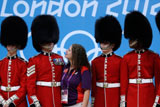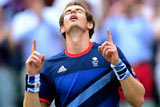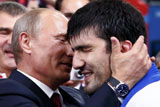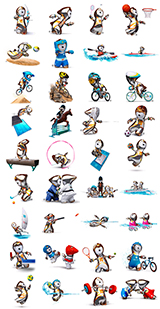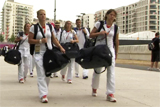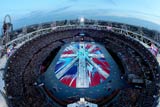Hockey
Updated: 2012-05-16 10:13:51
( london2012.com)
|
|||||||||||
Hockey demands speed, stamina and a mastery of intricate hand-eye coordination. Played by teams of 11 on an outdoor pitch, the sport is a long-time Olympic favorite, offering non-stop action over 14 days of competition. All matches will be played at the brand-new Riverbank Arena in the Olympic Park.
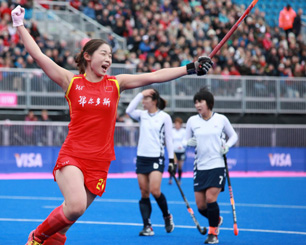
[Photo/Xinhua]
Competition dates:
July 29 - Aug 11
Competition venues:
Olympic Park - Riverbank Arena
Number of medal events
One men's and one women's competition.
Number of competitors:
192 men and 192 women. Twelve men's and 12 women's teams, with 16 athletes (11 players and five substitutes) on each team.
Each country is limited to one men's and one women's team.
Field of play:
The hockey pitches are 91.4m long and 55m wide. The goals at each end are 3.66m wide and 2.14m high. Each goal is surrounded by a D-shaped shooting circle. The penalty spot at either end is 6.4m from the goal.
Until the 1970s, hockey was always played on grass. However, top-level matches, including those at London 2012, now take place on water-based synthetic-turf pitches, which allow the ball to roll more smoothly and quickly.
For the first time ever at the Olympic Games, the London 2012 hockey pitch is blue, rather than green.
History of Hockey at the Olympic Games
Men's Hockey made its debut at the London 1908 Games. The first women's Olympic Hockey competition was held at the Moscow 1980 Games.
The basics
Players use hook-shaped sticks to advance a hard ball towards their opponents' goal. Matches are played over two halves of 35 minutes each.
The team is made up of attackers, midfielders and defenders. Each team also has a goalkeeper. Substitutions can be made at virtually any time, and any number of times.
To take a shot on goal, players must be inside their opponents' shooting circle.
Competition format
At London 2012, both the men's and women's Hockey competitions begin with a preliminary phase: the 12 teams in each competition are divided into two pools of six, and each team plays every other in their pool. The top two teams in each pool qualify for the semi-finals, the winners of which go head-to-head for the gold. The other teams in the two groups play each other to determine final placings.
In the preliminary phase, teams receive three points for a win and one point for a draw.
In the knockout matches, ties are resolved by extra time (two 7½-minute periods), with a golden goal - the first goal scored - winning the match. If still tied after this time, the match is decided by a penalty shootout of five shots per team. If the scores are still tied, the match is decided by sudden death penalties.
Officials
Two umpires control the match. They each control half the pitch and work together on decisions in the middle.
Keys to success
Hockey is a fast and physically demanding game. Players need to have speed, strength and stamina. They need excellent ball skills, great hand-eye coordination and the ability to play tactically as a team.
Breaking the rules
The umpires look out for rule infringements. For repeat offences players are shown cards - green as a suspension of two minutes, yellow for a suspension of at least five minutes, and red, for the most serious offences, sending the player off for the rest of the match, leaving the other team with a vital extra player.
For certain fouls, usually in the shooting circle, teams are awarded a penalty corner, where a player pushes the ball out from the back line to team-mates waiting around the shooting circle. They can then take a shot on goal against only five defenders. At other times a penalty stroke is awarded, where one player takes a shot from the penalty spot, defended only by the goalkeeper.
Jargon buster
Golden goal - if extra time is required during the knockout stages of the competition, the team that scores the first goal - the golden goal - wins the match.
Green card - an official warning that results in an automatic two-minute suspension. The umpire may also issue yellow cards (longer temporary suspensions) and red cards (removal from the game).
Penalty corner - awarded for a variety of different infringements (usually in the shooting circle), penalty corners are taken from the back line, 10m either side of the nearest goalpost. Only five defenders are allowed to defend penalty corners, which are also known as short corners.
Shooting circle - an arc in front of each goal; goals can only be scored from within the shooting circle.
Medal Count |
||||
| 1 | 46 | 29 | 29 | |
| 2 | 38 | 27 | 22 | |
| 3 | 29 | 17 | 19 | |
| 4 | 24 | 25 | 33 | |
| 5 | 13 | 8 | 7 | |
| 6 | 11 | 19 | 14 | |


